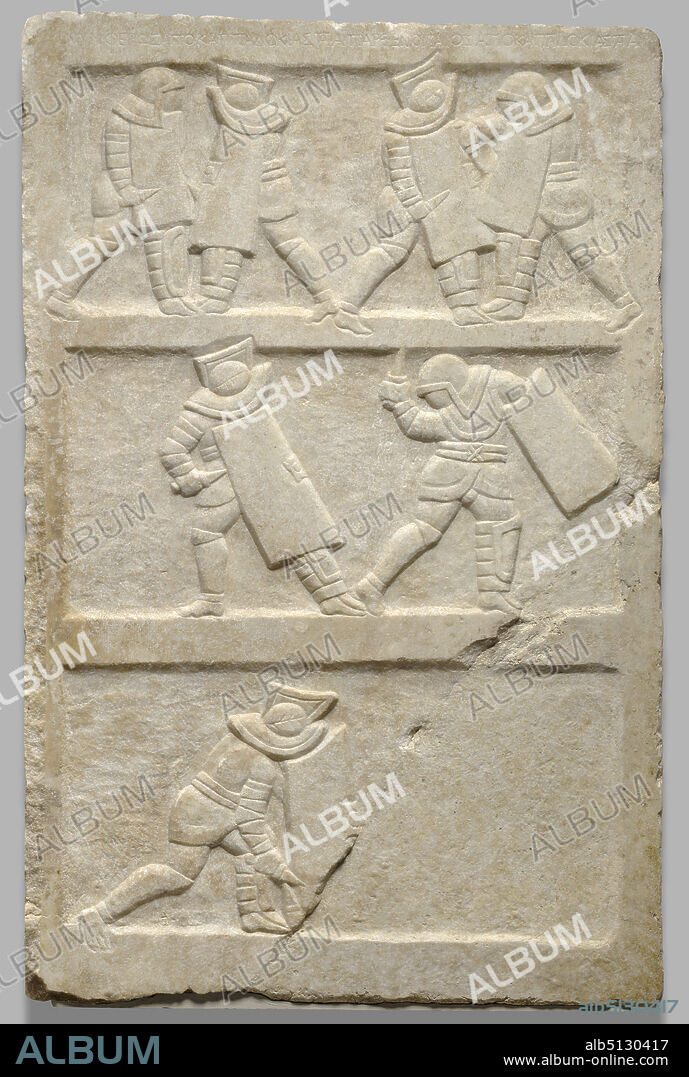alb5130417
Relief with Gladiators, ca. 2nd century A.D., Marble, 122.6 × 80.2 × 6.2 cm (48 1/4 × 31 9/16 × 2 7/16 in.), Gladiatorial games originated as funerary rites in which the deceased was celebrated through physical competitions. For this reason, relief depictions of gladiatorial combat were sometimes used as grave markersprobably not for gladiators themselves, but for those whose lives such games may have commemorated. The games were particularly popular during the Roman Empire; in fact, most of the known funerary depictions of gladiators are Imperial in date. As government sponsorship grew in the Empire, the games took on political overtones. By staging massive and elaborate series of combats that often lasted for months and involved the slaughter of scores of men and wild animals in arenas throughout the empire, the Romans culturally unified their territory and affirmed their power, both to create such dramatic spectacles, and over life and death themselves. , Roman, Roman, Sculpture.

|
Añadir a otro lightbox |
|
Añadir a otro lightbox |



¿Ya tienes cuenta? Iniciar sesión
¿No tienes cuenta? Regístrate
Compra esta imagen.
Selecciona el uso:

Descripción:
Ver traducción automática
Relief with Gladiators, ca. 2nd century A.D., Marble, 122.6 × 80.2 × 6.2 cm (48 1/4 × 31 9/16 × 2 7/16 in.), Gladiatorial games originated as funerary rites in which the deceased was celebrated through physical competitions. For this reason, relief depictions of gladiatorial combat were sometimes used as grave markersprobably not for gladiators themselves, but for those whose lives such games may have commemorated. The games were particularly popular during the Roman Empire; in fact, most of the known funerary depictions of gladiators are Imperial in date. As government sponsorship grew in the Empire, the games took on political overtones. By staging massive and elaborate series of combats that often lasted for months and involved the slaughter of scores of men and wild animals in arenas throughout the empire, the Romans culturally unified their territory and affirmed their power, both to create such dramatic spectacles, and over life and death themselves. , Roman, Roman, Sculpture
Crédito:
Album / quintlox
Autorizaciones:
Modelo: No - Propiedad: No
¿Preguntas relacionadas con los derechos?
¿Preguntas relacionadas con los derechos?
Tamaño imagen:
3359 x 4992 px | 48.0 MB
Tamaño impresión:
28.4 x 42.3 cm | 11.2 x 16.6 in (300 dpi)
Palabras clave:
ANIMALES SALVAJES • BAJORRELIEVE • BAJORRELIEVES • CREAR • DECEASED • DIFUNTO • EN RELIEVE • ESCULPIDA • ESCULTURA • FALLECIDO • GLADIADORES • HOMBRES • IMPERIAL • IMPERIO ROMANO • IMPERIO • MARBLE • MARMOL • MATANZA • MEN • PARTITURA • PODER • RAZON • RELIEF • RELIEVE (ARTE) • RELIEVE • RELIEVES • ROMA IMPERIAL • ROMANA • ROMANO • ROMANOS • VIDA
 Pinterest
Pinterest Twitter
Twitter Facebook
Facebook Copiar enlace
Copiar enlace Email
Email
